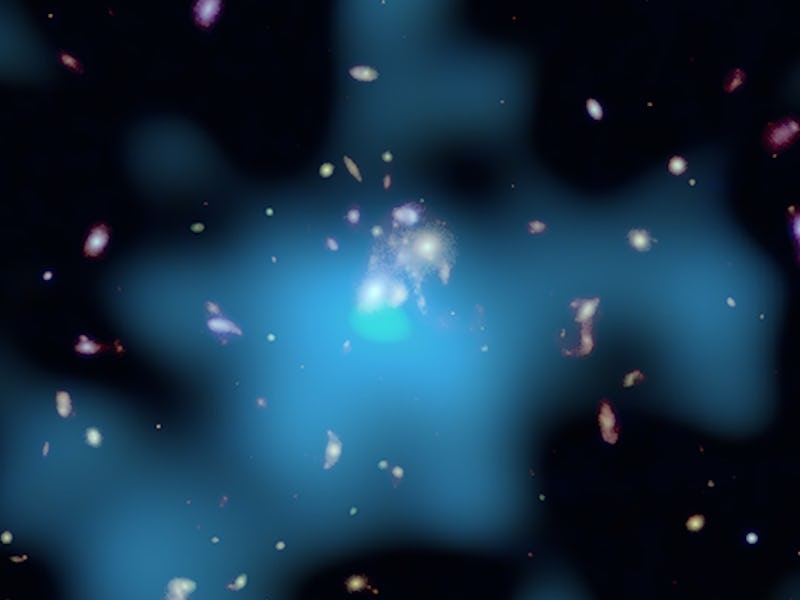When a black hole doesn't swallow everything up, something remarkable happens — study

Black holes are known for being cosmically ruthless. These objects of compact mass swallow up surrounding material, and not even light can escape their strong gravitational pull.
But what happens when a black hole is inactive, allowing material to float by in space.
Astronomers have recently observed a rather passive black hole, one that does not affect its surroundings in a distant galaxy cluster. Rather than swallowing up material itself, the black hole's inactivity allowed for surrounding star formation to flourish.
The discovery was detailed in a study published this week in The Astrophysical Journal Letters.
Chandra X-ray Observatory caught a glimpse of the passive black hole at the center of a galaxy cluster.
Using NASA's Chandra X-ray Observatory, as well as the Hubble Space Telescope and Spitzer Space Telescope, astronomers observed the black hole in a galaxy cluster that's located 9.9 billion light-years away from Earth.
They were first drawn to the galaxy cluster due to its unusual star formation activity. The stars were forming at a rate of about 900 new Suns worth of mass per year in the galaxy cluster dubbed as SpARCS1049. This star formation rate is over 300 times faster than that at which our own galaxy, the Milky Way, forms stars.
The team of astronomers behind the new study was wondering about the source of newborn stars in SpARCS1049, and they think it may have something to do with the galaxy cluster's black hole.
Further observations by Chandra revealed that while the temperature of gas in most of the galaxy cluster is about 65 million degrees, it is much denser and cooler about 80,000 light-years away from the center of SpARCS1049. That region is where the majority of the intense star formation is happening since stars require cooler gas in order to be born as the gas becomes molecular and its atoms can bind together.
The cooler gas, at lower temperatures of about 10 million degrees, suggests that other undetected gas reservoirs have cooled to even lower temperatures that would enable all of these stars to form.
With the black hole being inactive, it is not heating the surrounding gas. Therefore, the gas can cool down enough and allow for these huge numbers of stars.
“It reminds me of the old expression of ‘when the cat’s away, the mice will play,’” Julie Hlavacek-Larrondo, a researcher at the University of Montreal in Canada, and lead author of the study, said in a statement. “Here the cat, or black hole, is quiet and the mice, or stars, are very busy.”
Astronomers have long theorized that without the presence of active black holes swallowing up surrounding material in galaxies, star formation rates would be at an all-time high. The observations made in galaxy cluster SpARCS1049 is the first kind of proof for this theoretical behavior of black holes, and how they affect their surroundings.
“This kind of black hole shut down may be a crucial way for stars to form in the early Universe," Carter Rhea, a researcher at the University of Montreal, and co-author of the study, said in a statement.
The team of researchers also believe that the lack of dense gas at the center of the galaxy cluster is what is preventing the black hole from being a full-blown, active cosmic beast.The black hole lacks a source of fuel, which prevents outbursts.
Abstract: Cosmological simulations, as well as mounting evidence from observations, have shown that supermassive black holes play a fundamental role in regulating the formation of stars throughout cosmic time. This has been clearly demonstrated in the case of galaxy clusters in which powerful feedback from the central black hole is preventing the hot intracluster gas from cooling catastrophically, thus reducing the expected star formation rates by orders of magnitude. These conclusions have however been almost entirely based on nearby clusters. Based on new Chandra X-ray observations, we present the first observational evidence for massive, runaway cooling occurring in the absence of supermassive black hole feedback in the high-redshift galaxy cluster SpARCS104922.6+564032.5 (z=1.709). The hot intracluster gas appears to be fueling a massive burst of star formation (≈900~M⊙yr−1) that is offset by dozens of kpc from the central galaxy. The burst is co-spatial with the coolest intracluster gas but not associated with any galaxy in the cluster. In less than 100 million years, such runaway cooling can form the same amount of stars as in the Milky Way. Intracluster stars are therefore not only produced by tidal stripping and the disruption of cluster galaxies, but can also be produced by runaway cooling of hot intracluster gas at early times. Overall, these observations show the dramatic impact when supermassive black hole feedback fails to operate in clusters. They indicate that in the highest overdensities such as clusters and proto-clusters, runaway cooling may be a new and important mechanism for fueling massive bursts of star formation in the early universe.